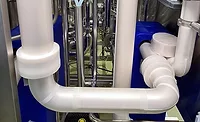Almond pasteurization system saves energy and space
Fluid-bed processors are outfitted with columns, airlock valves, blowers and heat exchangers.

To combat rare cases of salmonella, many California almond processors have installed steam pasteurization equipment to achieve a four-log reduction of the bacteria. In most installations, the equipment is oriented horizontally, but Hilltop Ranch, located in Ballico, CA, has taken a different approach. In a new gravity-driven system, almonds flow downward in a zigzag pattern through a vertically oriented, 22-ft. pasteurization chamber. This enables steam to be used throughout the column more efficiently, not only lowering energy consumption, but reducing equipment footprint by approximately 50 percent.
To further reduce energy consumption and floor space requirements, Hilltop installed two circular, vibratory fluid bed processing systems: the first for drying; the second for cooling the pasteurized almonds produced at a rate of 50 million pounds per year.
“Although the original pasteurization process was designed to incorporate horizontal fluid bed processors, circular units from Kason caught our interest,” says Charlie Jahn, quality manager for Hilltop. “We considered a few fluidized bed processors. Most work well but they’re twice as large, so they require extensive infrastructure and ancillary equipment, as well as energy-consuming levels of airflow,” he adds.
According to Jahn, a fluid bed processor had not previously been used for drying or cooling of almonds, so he specified the heat and moisture ranges required immediately after pasteurization, the cooling requirements after drying, and the throughput requirement of 22,000 lb/hr of almonds.
“We chose Kason K-84/100 fluid beds based on test results for both drying and cooling,” explains Dexter Long, VP, operations at Hilltop. “We like small footprints (84-in. diameter) and vertical systems.”
To remove excess moisture (6.8%), almonds exiting the vertical pasteurization chamber are metered by a rotary airlock valve into the circular fluid bed dryer. Imbalanced-weight gyratory motors cause the almonds to vibrate on a perforated plate within a rising column of heated, 180°F air, blown into the center of the fluid bed chamber from below by a 25-hp variable-speed fan. Continuous airflow and vibration separate and fluidize individual almonds, maximizing the rate at which drying to 4.5-5.5% occurs.
Heated almonds exit through a discharge spout at the periphery of the fluid bed dryer and are elevated 35 feet by a drag conveyor to the circular vibratory fluid bed cooler, which forces cool, 65

Almonds are conveyed from a holding tank (right) to a pasteurization tower (left of holding tank). Product proceeds to a fluid bed dryer (bottom) and then to a fluid bed cooler (top). Beneath the cooler is an equilibration tank where the almonds achieve uniform temperature. Source: Kason.
To combat rare cases of salmonella, many California almond processors have installed steam pasteurization equipment to achieve a four-log reduction of the bacteria. In most installations, the equipment is oriented horizontally, but Hilltop Ranch, located in Ballico, CA, has taken a different approach. In a new gravity-driven system, almonds flow downward in a zigzag pattern through a vertically oriented, 22-ft. pasteurization chamber. This enables steam to be used throughout the column more efficiently, not only lowering energy consumption, but reducing equipment footprint by approximately 50 percent.
To further reduce energy consumption and floor space requirements, Hilltop installed two circular, vibratory fluid bed processing systems: the first for drying; the second for cooling the pasteurized almonds produced at a rate of 50 million pounds per year.
“Although the original pasteurization process was designed to incorporate horizontal fluid bed processors, circular units from Kason caught our interest,” says Charlie Jahn, quality manager for Hilltop. “We considered a few fluidized bed processors. Most work well but they’re twice as large, so they require extensive infrastructure and ancillary equipment, as well as energy-consuming levels of airflow,” he adds.
According to Jahn, a fluid bed processor had not previously been used for drying or cooling of almonds, so he specified the heat and moisture ranges required immediately after pasteurization, the cooling requirements after drying, and the throughput requirement of 22,000 lb/hr of almonds.
“We chose Kason K-84/100 fluid beds based on test results for both drying and cooling,” explains Dexter Long, VP, operations at Hilltop. “We like small footprints (84-in. diameter) and vertical systems.”
To remove excess moisture (6.8%), almonds exiting the vertical pasteurization chamber are metered by a rotary airlock valve into the circular fluid bed dryer. Imbalanced-weight gyratory motors cause the almonds to vibrate on a perforated plate within a rising column of heated, 180°F air, blown into the center of the fluid bed chamber from below by a 25-hp variable-speed fan. Continuous airflow and vibration separate and fluidize individual almonds, maximizing the rate at which drying to 4.5-5.5% occurs.
Heated almonds exit through a discharge spout at the periphery of the fluid bed dryer and are elevated 35 feet by a drag conveyor to the circular vibratory fluid bed cooler, which forces cool, 65
Looking for a reprint of this article?
From high-res PDFs to custom plaques, order your copy today!





